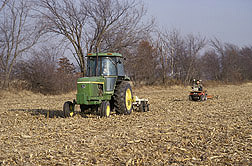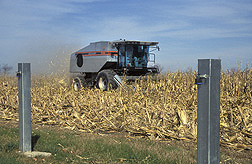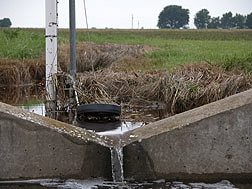Precision Agriculture Systems
Maximizing Benefits With Better Management
Good cooks don’t toss Worcestershire sauce in the ice cream or mint in the mashed potatoes. Instead, they season each dish with the best portions and combinations of spices to enhance its natural flavor.
That’s the concept behind precision agriculture, the practice of modifying management techniques to meet within-field variations that affect crop growth.
The premise of precision agriculture systems is that farmers should tailor their management to fit specific areas of their farms instead of using a blanket treatment for everything. This means recognizing areas that have productivity and environmental problems and selecting the best solution for each one. The outcome is a system that increases profitability and conserves environmental resources.
Researchers in the ARS Cropping Systems and Water Quality Research Unit (CSWQ) at Columbia, Missouri, are determining which combinations of precision-agriculture methods work best. Plenty of scientists are investigating the benefits of precision agriculture, but only a few are using an integrated approach, says soil scientist Newell Kitchen.
“Many scientists look at one variable, whereas we examine the interaction of many variables. We’re evaluating the system’s effects on production, profitability, and environment,” he says. This approach lets them assess, modify, and evaluate the effectiveness of integrated precision agriculture management practices.
Mind the Map
Between 1991 and 2003, CSWQ researchers monitored an 89-acre, conventionally managed claypan-soil field with a corn-soybean rotation, a common crop combination for that region of Missouri. Kitchen, with soil scientist Robert Lerch and agricultural engineer Ken Sudduth, measured soil and landscape variables and determined the causes of yield differences.
“We found that topsoil loss from the last two centuries of erosion on the field was a key factor in reduced productivity. Areas within the field varied in soil loss, and that had a major influence on patterns of soil quality, water quality, and crop yields,” Sudduth says.
In 2004, the CSWQ team analyzed the data they’d collected to determine how precision-agriculture management could best promote soil and water quality and profitability. Accurate representation of yield variability is a keystone of precision agriculture. So the scientists used different kinds of maps to identify areas where changes were needed to improve the field’s economic output.
Using profitability maps, yield maps, soil maps, and other data, the team created a management plan for the field. Because the maps indicated that corn could be grown profitably only in one section of the field, that area continued in a corn-soybean rotation while the rest of the field was switched to a wheat-forage-soybean rotation.
“We hope that our work will lead to information that farmers, consultants, and researchers throughout the country and around the world can use to make better, more informed decisions,” Lerch says.
|
|
EC-Zone Grown
One way to assess fertilization needs and soil variability is to use soil electrical conductivity (EC)—a measure of how easily soil allows an electrical current to flow through it. The CSWQ team was one of the first to apply EC readings to precision agriculture. Working with university and ARS colleagues, they investigated how EC relates to soil properties and grain yields. They also used EC to map where erosion had occurred within a field.
The team discovered that EC measurements and elevation (gauged with Global Positioning System—or GPS—equipment) were extremely helpful in identifying management zones. In fact, Sudduth says, zone maps created with this information were more accurate predictors of yield than maps made with traditional soil surveys. Using yield mapping and profitability analysis, the scientists identified areas of the field that were generally unprofitable. By monitoring those areas and analyzing computer models, scientists and growers can select the best management practices.
|
|
Making Sense of Nitrogen
While environmental conservation is an important potential benefit of precision agriculture, scientists recognize that growers will only adopt new technology if it cuts production costs or improves efficiency.
“Many farmers hear ‘precision agriculture’ and think about tools, such as mapping tools, reflectance spectrometers, or GPS. Our objective is to demonstrate how these tools can add value and how farmers can make sensible management changes,” says Sudduth.
Nitrogen application is one area where more precise management has multiple benefits. Growers don’t want nutrient-deficient crops, but excessive fertilization results in unnecessary expenses and can lead to leaching, runoff, and water pollution. The CSWQ team developed two management approaches to help growers identify fertilizer needs of specific sites within a field, allowing for more accurate application.
The first method assesses nitrogen deficiency by measuring crop-canopy reflectance. Scientists estimate that using this method in a cornfield might increase profits about $15 per acre. The second method—still in development—relies on an automated soil sampling and analysis system, which could quickly and economically predict the soil’s nitrogen-supplying capacity.
The researchers believe that combining the first assessment method with variable-rate fertilizer applications could benefit both the economics of corn production and the environment of corn-growing regions. By limiting fertilizer application to the amount required, growers could avoid many of the potential problems associated with nitrogen leaching.
During the next 5 years, the CSWQ team hopes to show that their methods decrease nutrient and sediment losses, increase profitability, and improve soil quality. Above all, they hope to demonstrate that precision agriculture can be an economically viable tool for farmers.
“This research directly benefits farmers by identifying technologies and methods they can use to improve efficiency of nutrients and pesticides, thereby increasing their profits,” Sudduth says.—By Laura McGinnis, Agricultural Research Service Information Staff.
This research is part of Water Resource Management (#201), Soil Resource Management (#202), and Integrated Agricultural Systems (#207), three ARS National Programs described on the World Wide Web at www.nps.ars.usda.gov.
Newell Kitchen, Kenneth Sudduth, and Robert Lerch are in the USDA-ARS Cropping Systems and Water Quality Research Unit, University of Missouri, Agricultural Engineering Bldg., Room 269, Columbia, MO 65211; phone (573) 882-1135 [Kitchen], (573) 882-4090 [Sudduth], (573) 882-9489 [Lerch], fax (573) 882-1115.
"Precision Agriculture Systems" was published in the March 2007 issue of Agricultural Research magazine.










